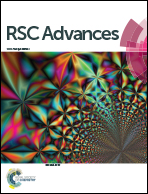Anisotropic gold nanoparticles for the highly sensitive colorimetric detection of glucose in human urine†
Abstract
Because of the difference in the surface energies of various crystal facets that arise from a large fraction of edges, corners and vertices, the morphology of nanoparticles has extreme potential for various applications. In this report, using poly(3,4-ethylenedioxythiophene) polystyrene sulfonate (PEDOT:PSS) functionalized anisotropic gold nanoparticles (GNPs) we have demonstrated a simple but robust method for the naked eye colorimetric detection of glucose in human urine with high sensitivity. Glucose oxidase (GOx) was conjugated to the modified anisotropic GNPs. The controlled degree of PEDOT:PSS attached onto the surface of the GNPs was crucial for the detection of glucose. The GNPs were aggregated and the color of the solution changed from pink to blue upon the addition of only 10 μg mL−1 of glucose. The detection limit for glucose was found to be 9.8 μM. Such highly sensitive naked eye detection using PEDOT:PSS will be very useful for low cost homemade sensors.


 Please wait while we load your content...
Please wait while we load your content...